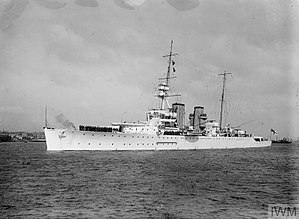
Back Ефингам (тежък крайцер, 1921) Bulgarian HMS Effingham (D98) German اچاماس افینگهام (دی۹۸) Persian HMS Effingham Finnish HMS Effingham (D98) French HMS Effingham Italian エッフィンガム (重巡洋艦) Japanese HMS Effingham (1925) Polish HMS Effingham (D98) Portuguese HMS Effingham Russian
 Effingham between 1925 and 1936
| |
| History | |
|---|---|
| Name | Effingham |
| Namesake | Lord Howard of Effingham |
| Ordered | December 1915 |
| Builder | HM Dockyard, Portsmouth |
| Laid down | 6 April 1917 |
| Launched | 8 June 1921 |
| Completed | July 1925 |
| Identification | Pennant number: 98 (1925);[1] I98 (1938); D98 (1940)[2] |
| Fate | Wrecked off Bodø, Norway, 18 May 1940 |
| General characteristics (as built) | |
| Class and type | Hawkins-class heavy cruiser |
| Displacement | |
| Length | 604 ft 10 in (184.4 m) (o/a) |
| Beam | 65 ft (19.8 m) |
| Draught | 19 ft 3 in (5.9 m) (deep load) |
| Installed power |
|
| Propulsion | 4 × shafts; 4 × geared steam turbines |
| Speed | 30.5 knots (56.5 km/h; 35.1 mph) |
| Range | 5,640 nmi (10,450 km; 6,490 mi) at 10 knots (19 km/h; 12 mph) |
| Complement | 690 |
| Armament |
|
| Armour |
|
| General characteristics (1938) | |
| Installed power |
|
| Speed | 29 knots (54 km/h; 33 mph) |
| Range | 5,410 nmi (10,020 km; 6,230 mi) at 14 knots (26 km/h; 16 mph) |
| Complement | over 800 |
| Armament |
|
HMS Effingham was one of five Hawkins-class heavy cruisers built for the Royal Navy during the First World War. She was not finished during the war and construction proceeded very slowly after the end of the war in 1918. Completed in 1925, the ship was assigned to the East Indies Station, sometimes serving as a flagship. She returned home in 1932 and was assigned to the Reserve Fleet as its flagship for the next four years. Effingham was rearmed and modernized in 1937–1938 and then resumed her previous role.
When the Second World War began in September 1939, Effingham was assigned to the Northern Patrol, but severe engine problems caused her to spend most of the next six months under repair. In between dockyard visits, the ship ferried a load of gold bullion to Canada and was briefly assigned to the North America and West Indies Station. After a lengthy refit at the beginning of 1940, Effingham supported Allied troops during the Norwegian Campaign, mostly bombarding German positions and providing naval gunfire support to troops ashore. While ferrying troops and supplies to Bodø on 18 May, the ship struck a shoal due to a navigational error and sank in shallow water. Her crew was evacuated without loss and the cruiser destroyed by a pair of torpedoes from an accompanying destroyer. Her wreck was salvaged after the war with only some minor wreckage remaining.
© MMXXIII Rich X Search. We shall prevail. All rights reserved. Rich X Search